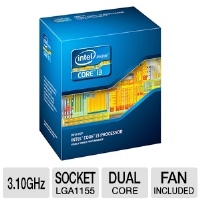 In 2011 the 2nd generation of the Core i3 processors was introduced. These processors were based on the Sandy Bridge architecture. This came as a straight replacement of the Clarkdale Core i3. What set the Core i3 2nd Gen processors apart from its predecessor is that these processors for the first time integrated graphics, processor and memory controller on the same die. As a result the overall size of the processors was reduced. Other distinguishing features of these processors are Intel InTru 3 D/Clear Video HD, Quick Sync Video and WiDi 2.0 which took the graphic performance of the processor to the next level.
In 2011 the 2nd generation of the Core i3 processors was introduced. These processors were based on the Sandy Bridge architecture. This came as a straight replacement of the Clarkdale Core i3. What set the Core i3 2nd Gen processors apart from its predecessor is that these processors for the first time integrated graphics, processor and memory controller on the same die. As a result the overall size of the processors was reduced. Other distinguishing features of these processors are Intel InTru 3 D/Clear Video HD, Quick Sync Video and WiDi 2.0 which took the graphic performance of the processor to the next level.
In addition to all these dynamic features the Core i3 2nd Gen processors included Intel’s Smart Cache. The Smart cache dynamically allocates the catch to the processor core as per the workload. In turn there is a substantial reduction in the latency which in turn helps to improve the overall performance of the processor. In Contrast with the Sandy Bridge based Pentium and Celeron processors, the Core i3 2nd Gen processors supported AVX instruction set (Advanced Vector Extensions). Just like Core i3 1st generation, the 2nd too does not support AES-NI and Turbo Boost.
The Core i3-21xx processors are the desktop models and the socket 1155 are used by these. These processors come with an integrated PCI Express2.0 controller supporting one x16 lane, that can be split into two x8 lanes to gain access to two discrete video cards. With the help of a DMI bus the communication with the motherboard chipset is carried out. These also include an integrated memory controller that supports dual channel architecture along with 1,333 MHz and 1,066 MHZ DDR3 memories. Every model of processor that falls under this category has an integrated DirectX 10.1 video controller that runs at either 650MHzor 850 MHz with either a 6 (HD2000) or a 12 (HD 3000) processing core.
The Core i3-23xx models are specially designed to cater to laptops. They come in two different types of pin outs: BGA1023 and PGA988. Like the desktop version these included integrated dual channel DDR3memory controller that supports 1,333 MHz and 1,066 MHZ DDR3 memories. The major difference between the desktop models and the laptop models is the clock range. The laptop models have a lower clock range on both the CPU and the integrated video controller. This aids in lesser battery consumption. There are two frequencies of the video clock, 350 MHz or 650 MHz.
how many pipeline stages does core i3 have???
In the Core series II processors (i3, i5, and i7), there are 14 stages in the processor pipeline.